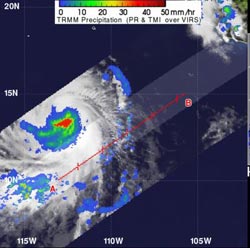NASA's TRMM Satellite sees heavy rainfall in Tropical Storm Daniel's center

The TRMM satellite passed over Tropical Storm Daniel on July 6, 2012, at 0034 UTC and data revealed heavy rain falling around the southern periphery of the center of circulation. The heavy rain (in red) was falling at a rate of more than 2 inches/50 mm per hour. The yellow, green and blue areas indicate light-to-moderate rainfall between 20 and 40 millimeters (.78 to 1.57 inches) per hour. Credit: SSAI/NASA, Hal Pierce<br>
When the Tropical Rainfall Measuring Mission (TRMM) satellite passed over Tropical Storm Daniel on July 6, 2012 at 0034 UTC, data revealed heavy rain falling around the southern periphery of the center of circulation.
The heavy rain was falling at a rate of more than 2 inches/50 mm per hour. TRMM is jointly managed by both NASA and the Japanese Space Agency, JAXA.
Daniel remains no threat to land, however, as the storm is expected to continue on a westward track into the open waters of the eastern Pacific over the weekend.
At 5 a.m. EDT (2 a.m. PDT) on Friday, July 6, 2012, Daniel was far from land. Its center was located about 640 miles (1030 kilometers) south-southwest of the southern tip of Baja California, near 14.6 North and 114.2 West.
Daniel's maximum sustained winds increased to 65 mph (100 kmh) and the tropical storm is moving west at 14 mph (22 kmh). The National Hurricane Center expects Daniel to continue moving in this direction over the weekend.
Media Contact
More Information:
http://www.nasa.govAll latest news from the category: Earth Sciences
Earth Sciences (also referred to as Geosciences), which deals with basic issues surrounding our planet, plays a vital role in the area of energy and raw materials supply.
Earth Sciences comprises subjects such as geology, geography, geological informatics, paleontology, mineralogy, petrography, crystallography, geophysics, geodesy, glaciology, cartography, photogrammetry, meteorology and seismology, early-warning systems, earthquake research and polar research.
Newest articles

Properties of new materials for microchips
… can now be measured well. Reseachers of Delft University of Technology demonstrated measuring performance properties of ultrathin silicon membranes. Making ever smaller and more powerful chips requires new ultrathin…

Floating solar’s potential
… to support sustainable development by addressing climate, water, and energy goals holistically. A new study published this week in Nature Energy raises the potential for floating solar photovoltaics (FPV)…

Skyrmions move at record speeds
… a step towards the computing of the future. An international research team led by scientists from the CNRS1 has discovered that the magnetic nanobubbles2 known as skyrmions can be…




















